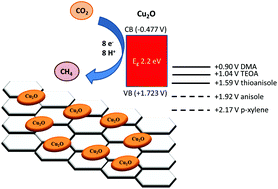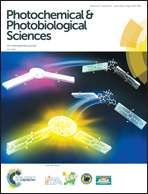The mechanism of photocatalytic CO2 reduction by graphene-supported Cu2O probed by sacrificial electron donors†
Abstract
Cu2O nanoparticles of 5 nm average size have been adsorbed (1.74 wt% loading) on defective graphene (Cu2O/G) previously obtained by the pyrolysis of alginic acid sodium salt. The Cu2O crystal phase was determined by XRD. XPS shows that the external layers of the Cu2O nanoparticles are constituted mainly of Cu+ although a certain percentage of CuII+ was also present. Cu2O/G is a photocatalyst for the CO2 reduction to methane in the presence of sacrificial agents, and the rate of CH4 production depends on the oxidation potential of the electron donor. This relationship supports a mechanism involving photoinduced charge separation with the generation of electrons and holes. The highest CH4 formation rate upon UV-Vis irradiation of Cu2O/G with a 300 W Xe lamp was achieved for dimethylaniline reaching 326 μmol CH4 per g per h. The spectral response of the Cu2O photocatalyst shows, however, that the response of the photocatalyst is mainly due to UV irradiation, indicating that light absorption at the low Cu2O loading on the Cu2O/G photocatalyst occurs mainly on the graphene component.

- This article is part of the themed collection: 28th International Conference on Photochemistry (ICP 2017)


 Please wait while we load your content...
Please wait while we load your content...